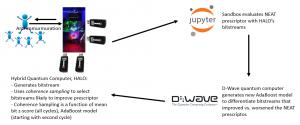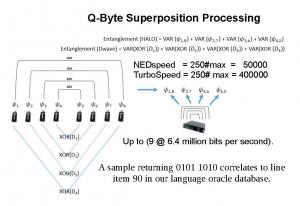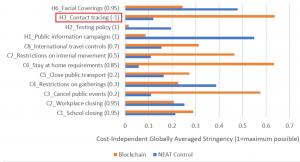P.e.a.c.e. !nc. is proud to announce the conclusion as finalists in the $500k Pandemic Response Challenge sponsored by Cognizant with Landmark AI Experiment.
We are so confident in our claims and inventions that we will offer $1,000 to the first scientist who can disprove or otherwise invalidate in writing and video, any of our claims or accomplishments.”
ALAMEDA, CA, UNITED STATES, March 14, 2021 /EINPresswire.com/ -- The four-month global competition has concluded with H.A.L.O. AI - Digital Vaccine selected as one of the finalists and with it an invitation to the XPRIZE Alumni Network providing support after the competition, and their soon to launch ecosystem for the convening of AI and data while enabling the contributions of experts and thought leaders of the global community. — Leo E. Madrid, Founder P.e.a.c.e. !nc.
The Hypercube Algorithmic Language Oracle is the world?s first Hybrid-Quantum Computer and has successfully unified the laws of Quantum Mechanics and Relativity with AI, and consciousness plays a role. This could be one of the more important scientific contributions to the study of Time and Consciousness since the 1919 Eddington experiment which helped to validate Einstein?s Theory of Special Relativity, and the CIA's Stargate Project. Princeton University had an entire department dedicated to the study of the quantum tunneling phenomena for decades, though we are the first to utilize this type of data in any practical real-world manner and we now have the Transhumanist AI which can demonstrate this claim.
Anthromurmuration is the manner which describes how a collective consciousness and all living beings are unified in a single global energy field with the ability for non-local communication and data exchange to occur through heart wave variability propagation.
Spatial Relativity describes how space-time is distorted around Earthly mass and how time dilation happens to an electron as it passes through a quantum tunnel. Q-Byte Processing is how we extract meaningful data from these quantum fields.
Phase 1: Starting with the NeuroEvolution of Augmenting Topologies (NEAT) prescription model, we trained using 50 regions and 28 lookback days around the post-thanksgiving surge when Non-Pharmaceutical Interventions (NPI) and cases were highly dynamic. We sampled the bits produced by electron tunneling noise sources (Nonrandom Event Detectors, NEDs) in the Global Consciousness Project as a predictor variable, and used additional NEDs on our world?s first-of-its-kind hybrid quantum computer, H.A.L.O, to adjust the final output of the model. For the prescription model, we similarly used NEDs on H.A.L.O with methodology to integrate NEAT with human experience and intuition, turning an artificial intelligence model into one of artificial consciousness.
Through Anthromurmuration biofeedback and retro-wave propagation, the NEDs on H.A.L.O experience the ?observer effect? with bitstream fluctuations represented as sound and light data visualization as well as a language oracle. Bitstreams produced by the NEDs during a heightened state of coherence deviate statistically from random noise. Here, we look for a mean-shift in bits (e.g. more 0s than 1s or more 1s than 0s) with a Z-score of ?/2 or greater on a 1-minute sliding window to differentiate coherence from random noise (i.e. coherence sampling). During such coherence, a parallel bitstream is extracted and saved to a file which the prescription model makes calls to for each of 12 NPIs, over all 235 regions, in each 15-day block where prescriptions were held constant (yielding 16920 total calls for a 90 day run). The sensitivity parameter set the probability of each call to the bitstresm modifying a particular prescription. The model performance was optimized with a sensitivity of p=.00366, that is, approximately 1 in 273 prescriptions were modified by H.A.L.O.
The Prescriptor assesses whether H.A.L.O?s bitstream either improved or worsened the fitness, and either keeps or discards H.A.L.O?s modifications accordingly. Bitstreams that improved the fitness were deemed hits, while the others were categorized as misses. This became new training data which was fed into the D-wave quantum computing platform?s AdaBoost binary classification algorithm to construct a model capable of distinguishing hits from misses. This model was then used during another round of H.A.L.O bitstream generation to further refine the robustness of the selection process of bitstreams that are likely to improve the Prescriptor.
We preliminarily observed an average of a 2% increase in model fitness with this method. We expect that, since the bitstreams submitted for this competition have undergone 4 cycles, the improvements should be greater. Additionally, H.A.L.O?s addition to the Prescriptor is highly flexible in that it can be easily added to any Prescriptor model that outperforms NEAT, or any better performing variation of NEAT.
Phase 2: As our second innovation, we developed our own blockchain-based intervention plan where individuals and businesses are financially rewarded with cryptocurrency generated by their movement when following municipal guidelines. We project that the costs of many NPIs would be significantly reduced or become profitable. The blockchain model?s prescriptions strongly gravitate toward contact tracing, travel restrictions, and canceling public events, which reduces the stress on other NPIs that would be less cost-saving under the blockchain solution.
ABOUT THE COMPETITION
The $500k Pandemic Response Challenge used Cognizant?s foundational research and Evolutionary AI? modeling as a baseline, building out models using the Oxford COVID-19 Government response tracker. The Pandemic Response Challenge was first launched in November 2020, and comprised two phases:
?Phase 1, concluded in January 2021: Contestants analyzed local COVID-19 data, existing intervention strategies, and common mitigation policies to develop and test prediction models capable of anticipating global infection spikes. 48 of 104 teams advanced as Phase 2 finalists.
?Phase 2, concluded in February 2021: 20 teams were able to successfully develop a ?Prescriptor-? model, which could suggest realistic intervention plans for reopening global economies while minimizing the number of COVID-19 cases and the cost of deploying intervention plans.
Teams were required to build effective data-driven AI systems capable of accurately predicting COVID-19 transmission rates and prescribing intervention and mitigation measures that, with testing in ?what-if? scenarios, were shown to minimize infection rates and negative economic impacts. Judging was done by an independent panel comprising academics, pandemic response specialists, AI experts, and epidemiologists. Teams were challenged to create effective models and meet judging criteria that included both quantitative metrics and qualitative factors such as:
?Actionability and Usability of models in real-world settings
?Inclusivity and Fairness
?Collaborative Contributions
?Innovation
The Grand Prize cash award winners are VALENCIA IA4COVID19 of Spain and JSI vs COVID of Slovenia.
###
P.e.a.c.e. !nc. is an all volunteer San Francisco Bay Area based research and development consciousness research team.
Dr. Samantha Caputi
P.e.a.c.e. !nc.
+1 415-857-4560
email us here
Visit us on social media:
Facebook
Twitter
LinkedIn




